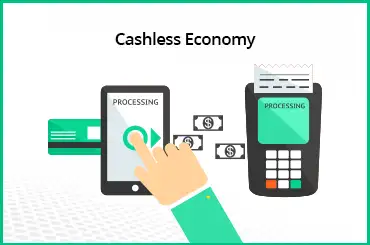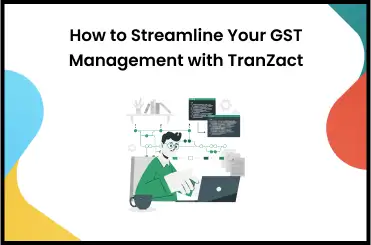The GST return filing form is crucial to claim an input tax credit (ITC) based on the taxpayer's classifications. There are a total of 13 different GST returns i.e. the GSTR-1, GSTR-3B, GSTR-4, GSTR-5, GSTR-5A, GSTR-6, GSTR-7, GSTR-8, GSTR-9, GSTR-10, GSTR-11, CMP-08, and ITC-04.
The introduction of the Goods and Services Tax (GST) in India in 2017 has made filing tax returns much easier by combining data from sellers and purchasers. This played a key role in unifying the nation and its taxation requirements.
The GSTN (goods and services tax network) method was developed by the GST Council and the finance ministry. This was done to ensure that taxpayers accurately record their sales and purchases. With this streamlined system in place, GST-registered taxpayers can quickly and conveniently fill in the GST return filing form.
There are distinct categories of taxpayers i.e. regular taxpayers, composition taxable persons, and Tax Deducted at Source (TDS) deductors. This also includes non-resident taxpayers, input service distributors, casual taxable persons, and e-commerce operators. It's important to remember that GST Returns can be submitted monthly, quarterly, or yearly.
In this comprehensive guide to understanding GST, we have explained the GST filing process, different types of GST returns, and components of GST returns. We will also dive deep into various GST return formats, the GST return process for different taxpayers, common GST mistakes, and more.
Understanding GST Return Filing
Goods and Services Tax (GST) return filing refers to the process of reporting your business's sales, purchases, and tax liability to the tax authorities.
Here are some key points to understand about GST return filing:
Filing Your GST Return Online
The instructions below outline the process for GST return filing electronically.
Step 1: Go to www.gst.gov.in, the official GST portal.
Step 2: At this stage, a 15-digit numeric code will be allocated to you based on your PAN number and state code.
Step 3: Upload every invoice, with a unique identifier assigned to each invoice.
Step 4: Submit the monthly cumulative return, the monthly inbound return, and the monthly outbound return. It is possible to fix any mistakes.
Step 5: By the 10th of every month, submit the GSTR-1 information portion of the outward supply returns using the GST common portal.
Step 6: The GSTR-2A is extracted for the supplier's outbound shipments.
Step 7: Once the details of the outgoing supplies have been confirmed, the recipient can record the information on any credit or debit notes.
Step 8: Fill out the GSTR-2 form with information on incoming supplies of goods and services.
Step 9: Suppliers can accept or reject the GSTR-1A's inbound supply details.
Read Also - Demand Management: Functions, Process, and Examples
Offline Process
If you are unable to file GST returns online due to technical difficulties or other reasons, you may have the option to file your returns offline using the offline utility provided by the GSTN (Goods and Services Tax Network). The offline tool helps you to submit your GST returns without an internet connection. After installing this program, completing both the GSTR-1 and GSTR-2 forms is fairly simple. Adhere to the instructions explained in the previous section.
Different Types of GST Returns
The various types of GST returns are described here.
GSTR-1
A company's sales and service transactions must be reported with the GSTR-1 form. Invoices and credit and debit notes related to sales throughout the accounting period are included here.
GSTR-2A
The Goods and Services Tax Return Form 2A (GSTR 2A) is a "view-only" auto-generated form. It lists everything the recipient bought during that month. Any goods or services received by the recipient from another GST-registered supplier are considered purchases by the recipient.
GSTR- 2B
GSTR-2B too is a purely informational GST monthly report that is static. GSTR-2B is generated for every normal taxpayer and the information is captured from the GST return filed by the taxpayer's suppliers.
GSTR- 3B
The GSTR 3B form is a monthly self-declaration. It provides a quick rundown of the following:
- All export provisions secured
- Tax deductions claimed as inputs
- Tax obligation
- Payment of taxes
GSTR-4
Composition-taxable persons must submit a GSTR-4 return annually. The due date is April 30 of the year after the end of the fiscal year being reported on. This form is now being used instead of GSTR-9A.
GSTR-5
Foreign taxpayers who are not Indian residents but who conduct business in India must fill out Form GSTR-5. How exactly do these refunds work? They include specifics like:
- Provisions shipped out
- Receipt of incoming supplies
- Payment coupons
- Tax obligation
- Payment of taxes
GSTR-5 A
The Online Information and Database Access or Retrieval Services provider's (OIDAR's) GSTR-5A report summarizes all of the taxable supplies made to outside customers and the tax owed on those sales. This report is due on the 20th of every month.
GSTR-6
Any business that provides input services must submit monthly GSTR-6 forms. Specifics about its components include:
- Input Tax Credit Disbursement and Accumulation by the Input Service Distributor (ISD)
- Input tax credit documentation in its entirety
Each month on the 13th, you must submit your GSTR-6.
GSTR-7
Those collecting tax deductions at source under GST must complete Form GSTR-7. It details the following:
- TDS Deduction Information
- Tax Deductible at Source Obligation Paid
- Any applicable tax refunds
- The 10th of every month is when you need to submit your GSTR-7.
GSTR-8
Those in the GST-compliant e-commerce business must fill out and submit this form. They are typically obligated to collect taxes directly from customers. The e-commerce platform keeps a complete record of all transactions, including all transactions performed during Tax Collection at Source (TCS). Every month by the 10th, you must submit it.
GSTR-9
Taxpayers who are GST registered must submit a yearly return. The deadline for this is December 31, the year after the fiscal year in question.
What information is found on a GSTR-9? The following components make up this set: • Specifics of all shipments done abroad • Receipt of Incoming Supplies • Compilation of Incoming Materials by HSN Number • Exact amounts of taxes owed and paid
GSTR-9C
All GST-registered taxpayers with an annual sales amount that exceeds Rs. 2 crores are required to file this form. Earlier, a Chartered Accountant (CA) or Cost Management Accountant (CMA) was required to review the GSTR-9 and certify it as accurate following a GST audit. However, the Union Budget 2021 states that CA and CMA GST audits are no longer required. The deadline for filing is December 31, the year after the fiscal year for which the return is being filed.
GSTR-10
A person whose registration has been canceled or relinquished must complete Form GSTR-10. It is also a final return and must be submitted three months after the cancellation order or cancellation date.
GSTR-11
The GSTR-11 form is used to issue tax refunds to diplomatic missions and embassies from countries without paying income tax in India. To receive a refund for purchases made in India, customers who have been issued a Unique Identification Number (UIN) must complete this form. The inbound supplies and claimed refunds are documented in these forms.
Having understood the various types of GST return filing, let's see the penalty for late filing.
Read Also - What Is Integrated Goods and Services Tax (IGST)?
What is the penalty for the late filing or non-filling of GST returns?
Interest and a late fee will be paid if the GST is not paid on time. To be applied to the total amount of tax still owed, interest at 18% per year will be charged. In addition, a daily Rs.100 late fee is due for CGST and for SGST, the same is Rs. 200.
Components of GST Return
Here, we'll explain what the components of GST return are.
Outward Supplies
When referring to a taxable person, "outward supply" refers to any supply of goods or services, or both, made or promised to be made by such person whether by sale, transfer, barter, exchange, license, rental, lease, or disposal, or any other form.
Inward Supplies
An "inward supply under GST" is acquiring products or services from a third party, whether for monetary or nonmonetary compensation. Your company is considered an inbound supply under GST since it receives supplies, which include purchases and expenses from other businesses.
Input Tax Credit
'Input Tax Credit' or 'ITC' refers to the Goods and Services Tax (GST) paid by a taxable person on any purchase of goods and services used or used to operate a business. After meeting certain requirements, a taxable person may deduct the ITC value from the GST owed on sales.
Tax Liability
In most cases, GST must be paid by the business or individual providing the service or commodities. However, the liability may be transferred to the recipient using the reverse charge system in certain circumstances, such as imports and other notified suppliers.
Read Also - What Is Production Control?
GST Return Formats
Depending on the nature of the taxpayer's business and the state in which they are registered, a separate format must be used when filing GST returns.
GST return formats are as follows:
GSTR 1
A registered taxable supplier must submit a GSTR-1 form with information on their outbound shipments of goods and services. Once the supplier completes the form, the buyer must review the pre-filled purchase data on the form and make any necessary changes.
GSTR 2
A registered taxable receiver is required to provide information about the goods and services that have entered the country on Form GSTR-2.
GSTR 3
The information from the taxpayer's GSTR-1 and GSTR-2 returns forms will be pre-populated into the GSTR-3 form. The taxpayer is responsible for double-checking and making any necessary changes.
GSTR 4
Taxpayers who have chosen the Composition Scheme are required to submit the GSTR-4 form. With the Composition Scheme, taxpayers whose businesses have a turnover of up to Rs.75 lakh can pay tax at a flat rate determined by their industry. Under this plan, taxpayers cannot claim input tax credits.
GSTR 5
All taxpayers who are not residents of India must submit a GSTR-5 form.
GSTR 6
All taxpayers with Input Service Distributor registrations must submit GSTR-6 forms.
GSTR 7
All taxpayers with a GST registration who have a tax withholding obligation must submit a GSTR-7 form.
GSTR 8
To comply with the GST legislation requiring them to collect tax at source, all e-commerce businesses must submit a GSTR-8 form. Subsection (1) of Section 43C of the Model GST Law requires that tax collected be reported on this form.
GSTR 9
A standard taxpayer's annual income and expenses must be detailed on form GSTR-9. This information will be reorganized every month to reflect the returns. If necessary, the taxpayer can edit the previously submitted data.
The GSTR-9 form and copies of the audited financial statements must be submitted by the end of the calendar year following the fiscal year being reported.
Read Also - What Is E-Invoice In GST?
GST Return Process for Different Taxpayers
It is essential to know the GST return process to follow it right, Let's see what the process is like for different taxpayers.
Regular Taxpayers
Every GST taxpayer who is registered and who makes regular tax payments must submit a return each year. Form GSTR 9 must be used by regular taxpayers for annual reporting purposes. However, those whose registration has been terminated are still required to file a GSTR 10 final return.
Businesses with an annual aggregate revenue of more than Rs.5 crore (and taxpayers who have not opted for the QRMP scheme) must file two monthly and one yearly return under the GST regime.
Composition Scheme Taxpayers
A composition scheme taxpayer must file GST Return Form GSTR-4. A dealer participating in the composition scheme only must file one return per year, GSTR 4, and they only have until April 30, after the financial year ends to do so. Therefore, any taxpayer participating in the Composition Scheme must submit a GSTR-4. This includes the new service provider special composition scheme announced in CGST Notification No. 2/2019, dated March 7, 2020, for the 2019–20 fiscal year.
E-Commerce Operators
Every GST-registered online merchant must submit GSTR-8. According to the Goods and Services Tax Act, the term "E-commerce Operators" refers to the owner or manager of an electronic or digital facility or platform used for conducting business online.
All e-commerce businesses must be registered for GST and comply with TCS (Tax Collected at Source) regulations to conduct business in India legally. The GSTR-8 form provides information on e-commerce platform sales and the total TCS received on those sales.
Read Also - The Ultimate Guide to Purchase Requisition
Input Service Distributors (ISD)
By the 13th of the month following the month in which the tax credit was distributed, the Input Service Distributors (ISDs) are required to file GSTR-6 detailing the amount of tax credit distributed. The GSTR-2B return contains the ITC details that the ISD needs.
Invoice and payment processing for businesses that incur a high volume of identical expenses can benefit from the ISD model. This facility will ensure the smooth flow of credit under GST; it is designed to make taking credit easier for businesses.
Common Mistakes and Challenges in GST Return Filing
Here are the common mistakes in GST return filing:
Not filing GST returns when sales were zero
One common GST mistake is not filing a GST return, if there are no sales. You must complete GST return filing even if you had no sales activity. You'll have to pay a fine if you don't file your GSTR before the deadline. Make sure to file Form Nil, if your taxable sales during a given period totaled zero or not taxable.
Misclassifying GST payments as something else
Many companies have suffered losses because they made GST payments in the wrong category during GST return filing. Make sure you're paying your GST tax in the correct bucket when filing your returns. You should prepare for tax filing by gathering accurate information or you can hire a CA to do so on your behalf.
Understanding Nil-rating and zero-rated supplies
Sometimes, people get confused between the two. Nil-Rated Supplies are those items that are essential like food items and human blood and there is 0% GST on them. Therefore, ITC is not available on nil-rated supplies as GST does not apply to them.
However, when it comes to imports and exports, you must understand that exports are treated as zero-rated supplies. This does not imply that there is no need to file a GST return. You need to file a return and any taxes incurred throughout importing or exporting will be reimbursed as ITC.
To incur unwelcome reversal fees
Many vendors need to correct this practice when submitting their GST reports. The Reverse Charge Mechanism requires the recipient, rather than the supplier to cover the cost of any tax levied in connection with a certain delivery.
It is the responsibility of the recipient to pay the applicable tax in some circumstances, such as when receiving materials from an unregistered source.
Incorrect data entry for periodic reports
You must square off your annual number with your monthly and quarterly totals for GST return filing. It's important to pay attention to all the details as your GSTR-9 could be rejected for the smallest of reasons. Ultimately, this will result in a demand letter from the GST office.
Use TranZact for GST Returns!
TranZact ERP solution is a software that helps small and medium manufacturing businesses to manage all the key business functions effortlessly. It automates Sales, Purchases, Quotations, Inventory, and Production.
This is not all; it offers Tally, BUSY, and Excel integration for ease of use. It also assists in GST return filing by helping you prepare e-invoices, and GST-complaint documents easily.
Call us today to understand how it works and helps in overcoming challenges in GST return filing.
FAQs on GST Return Filing
1. Does GSTR-1 need to be submitted even if no transactions occurred during the reporting period?
Yes, even if no sales or other commercial activity occurred during the reporting period, a GSTR-1 must still be submitted. So, it's important to highlight that the GST returns contained zero entries.
2. Can the provider change the papers if the recipient does not act immediately?
No, the provider cannot change the papers for GST return filing in India if the recipient does not act immediately. The supplier must explicitly reject the document before the recipient can change it.
3. Can a taxpayer extend the time between filings?
The taxpayer can adjust the reporting period once. This must be done before the first return is submitted for the fiscal year.
4. Can an error in form ANX-1's table entry for a document's details be changed?
Once the intended recipient has rejected such documents, the option to modify the table contents becomes available. Before its rejection, no details on the document can be changed.
















